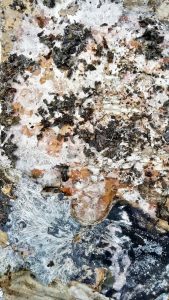Scratch beneath the surface, and this too is a season of new life, as the alchemical magic of leaf mouldering gets underway.
Autumn may signal death and decay for some, but in my garden it’s when renewable, replenishing new life actually arrives (and no, it’s not a load of steaming manure). This vitalising, life-bringing force is falling, literally, from horticultural heaven all around us.
Trees might be shedding – some spectacularly – their dead, job-done leaves as they prepare for a winter nap, but every gold, orange and russet cast-off that falls about my garden will, through the unhurried magic of mouldering, become part of a crucible for new life.

Life gets off to a flying start here the moment fallen leaves are gathered together. I have access to lots of leaves, so I pour them into 2m wide and 90cm deep circular cages made from found stock fencing (the serendipitous arrival of cage-encircling wild honeysuckle adds a living, fragranced ‘wrap’).
The first sign of life is heat: a big mass of leaves will warm up enough to send a plume of steam into chilly autumn mornings. This is a palpable sign of unseen microbial life thriving, exploding – the first wave of nature’s alchemy that slowly turns intact leaves into soft, crumbling leaf mould (smaller cages won’t heat up, but the breakdown bugs will still be busy). It’s lazy to talk about ‘making’ leaf mould; we gardeners don’t make it, we just cheat a little by raking and stacking leaves up, then let nature do the hard, slow work.
As we sink deeper into autumn, life puts on a sudden, overnight show. Toadstools sprout from a hidden, multidimensional web of hungry mycelium threading throughout the leafy mass, hard at work disassembling the tough, shiny and leathery, as decomposition lifts off. Follow-up flushes of toadstools can appear year-round, often following a bout of cage-soaking rain.
Airborne life abounds. Clouds of tiny flies flock to my leaf mould cages, lured by the damp, warm, delicious scent of decay. Next come the fly-seeking wrens (they tried to nest in a cage side one year), the dunnocks, the robins, the leaf-flicking, grub- and slug-hunting blackbirds and thrushes, and the scornful, acorn-burying jays hiding away their winter tucker. Because acorns are so prolific in this mast year, I’ve got fingers crossed that our corvids will be extra-forgetful, meaning that I’ll be able to reap oak seedlings to pot up and grow on for a little citizen rewilding.

Laying sheets of cardboard (sans plastic tape) over the top of my cages is useful both in helping shed our legendary winter rains, and for keeping the sinking leaves moist in summer. But it also creates a thin, cosy habitat buzzing with life atop the crumbling leaves. In the gaps between the cardboard, beetles, woodlice, millipedes, centipedes and spiders, plus a vast supporting cast of other, almost invisible arthropods, creep, crawl, scurry, hide and hunt. Slugs and snails take cover here, too; on warm, quiet nights I can hear them rasping at the card. I’ll cheer when I hear thrushes smashing open snail shells at first light on spring days.
Each layer of damp, mushy cardboard – which fungi love to feast on – gradually disintegrates into the fragmenting leaves, helping sate the armies of small red and orange composting worms that journey up and into the cage. Wasps touch down here in spring, gathering pulp to craft palaces for their queens. Adding more cardboard – brown, not the glossy, better-recycled stuff – ensures that this thin, diverse layer of all-year-round life abounds.
Down at the base of the leaf cage, life is on the move. Frogs, toads, slow worms and newts all take cover in the mouldering leaves during autumn, to either hole up during the day, or hunker down to hibernate for the winter. This requires a gentle touch when, after two to three years, I begin to harvest mature leaf mould from my life-filled cages. Spring and summer harvests are the least risky; wildlife is more active and quick to scarper. If I’m gathering in winter, I’m constantly on the lookout for torpid toads and sluggish slow worms, nestled in their leafy bunkers.

Harvesting mature leaf mould is life-enhancing in itself. The sublime, earthy smell of moulder, of slowness, of promise. The soft, crumbly texture, the gentle, cool springiness. The rich, dark colour, a jigsaw made in nature from thousands of bygone leaves. Running leaf mould through my fingers is akin to a divine, sacred moment. I feel like I don’t want to use it around the garden; I want to hoard it instead, to give it a bit longer to mature, to put off the day when I deploy its life-enriching properties far and wide.
But those days must come. They arrive when I fork leaf mould into the surface of my no-dig beds, where it helps boost soil microbial life, fattens earthworms, encourages friendly fungi to flourish, and helps to squirrel away carbon, as dark, soil-building humus. On other days, I use younger, coarser leaf mould as a weed-stifling mulch (cue the blackbirds, who flick among it). Rainy days in my greenhouse find me using it to add unseen life to a home-made, ultra-local, zero-footprint, plastic- and peat-free potting mix. Every few days I’ll scatter a handful of leaf mould into my ‘cool’ composting bins, to keep the life in them ticking over.
So autumn can bring it on, with all its mists and mellow promise of ending and decay. I’m ready with my rake, my boards and my wheelbarrow; a big empty cage awaits. I’m ready for a new start, ready to renew and replenish, ready to bring new life on.
Text and images © John Walker
Find John on Twitter @earthFgardener










